 |
 |
|||||||||||||||||||||
|
||||||||||||||||||||||
AZFO FIELD EXPEDITION
Mogollon Rim / Blue Ridge Snowmelt Drainages
August 15-17, 2014
By Eric Hough
Many passerines and other migrants stop over during fall migration along high elevation ridgelines and mountain drainages to forage during the day before continuing south on their nocturnal flights. In Arizona, monsoon moisture from July through September provides abundant insects, fruits, foliage, and flowers for birds to forage on in mountains throughout the state. The Mogollon Rim, a long escarpment forming the southern edge of the Colorado Plateau in the central part of the state spanning the area from Flagstaff southeast to the White Mountains region, is a major migratory corridor for these southbound neotropical migrants, including hummingbirds, flycatchers, vireos, warblers, and tanagers. Despite its relative proximity to major metropolitan areas in the state, this region still remains under-birded. Avian research over the past several decades and recent surveys for the “Mogollon Rim Snowmelt Draws” Important Bird Area (IBA) have focused mainly on breeding species, rather than the migrants that use this area as a stopover on their flyways. On this expedition, we focused on surveying for fall migrants within these mixed conifer snowmelt drainages and ridgelines to help better document the importance of this region as a migration corridor, which has the potential to aid in future forest management considerations within the IBA and surrounding lands. In addition, we recorded breeding evidence among the summer resident forest birds. The full species list from the expedition can be found at the bottom of the report in Table 1 of Appendix A.
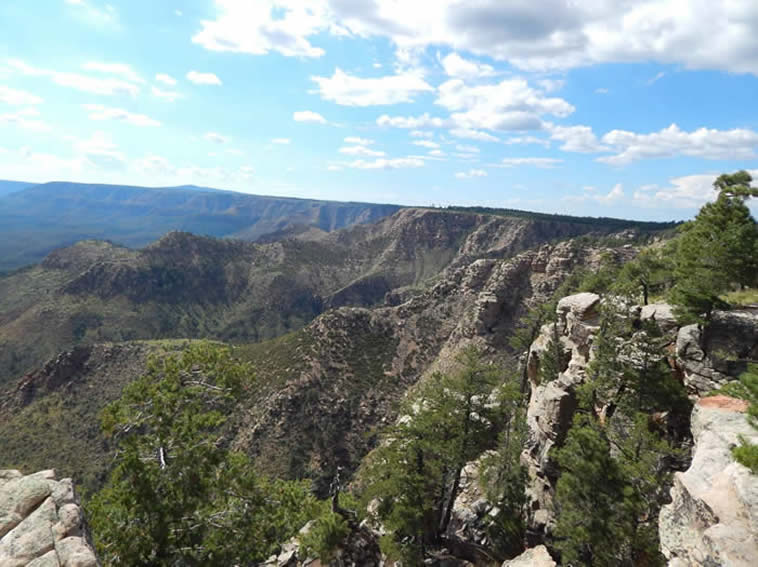 |
| Figure 1. The southern slope of the Mogollon Rim escarpment (© Eric Hough). |
Friday, August 15, 2014
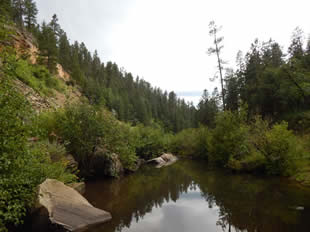 |
| Figure 2. East Clear Creek (© Eric Hough). |
On Friday, participants drove from Snowflake, Scottsdale, Sierra Vista, and Flagstaff to meet up in the early afternoon to find a campsite and go birding along East Clear Creek east of Blue Ridge Reservoir above the Mogollon Rim. Early in the afternoon I met with Marceline Vandewater, co-leader of this expedition, and John Barthelme to bird along East Clear Creek off Forest Rd. 95. Upon arriving along the creek, the typical afternoon monsoon storms of this time of year had built up and began to dump rain and strike lightning nearby with thunder booms echoing throughout the canyon. Once the rain let up, we headed west on a trail along the creek. East Clear Creek is a north-flowing drainage that eventually flows into the Little Colorado River near Winslow. On this upper stretch of the creek near the Mogollon Rim, vegetation consists of higher elevation species such as thinleaf alder (Alnus tenuifolia), shrubby willow species (Salix spp.), and boxelder (Acer negundo). On the slopes above this portion of the creek, the forest composition is dominated by ponderosa pine (Pinus ponderosa) and Gambel oak (Quercus gambelii), with Douglas-fir (Psuedotsuga mentziesii) on north-facing slopes and the typically lower-elevation beargrass (Nolina microcarpa) and banana yucca (Yucca baccata) in the understory on the south-facing slopes.
One of the first birds we encountered was a beautiful Red-faced Warbler, which seemed a good omen to us being that this species is AZFO’s symbol! Nearby along the creek we encountered several Virginia’s and Wilson’s Warblers, with smaller numbers of Orange-crowned, MacGillivray’s, Yellow, and Yellow-rumped Warblers. We also detected family groups of Canyon and House Wrens, Spotted Towhees, and ‘Red-backed’ Dark-eyed Juncos with streaky young noisily following after their parents for food. All of the action along the creek also drew the attention of predators, with a Sharp-shinned Hawk swooping into the willows after a smaller bird. High-pitched calls from across the creek revealed the presence of a couple of Cordilleran Flycatchers possibly lingering on their summer breeding territory. As we meandered along the creek looking at birds and the abundant wildflowers, we were surprised to hear the distinct whistled toots of a pair of Northern Pygmy-Owls calling to each other! This diurnal species of owl typically calls at dawn and dusk, and less often during the day while they are off hunting. Another interesting diurnal creature typically associated with the night that we encountered was what turned out to be a western firefly or lampyrid beetle (Ellychnia sp.), a species that lacks the bioluminescence of the well-known eastern species of fireflies.
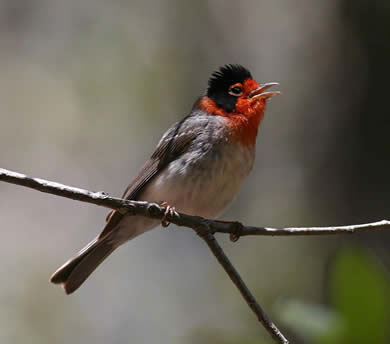 |
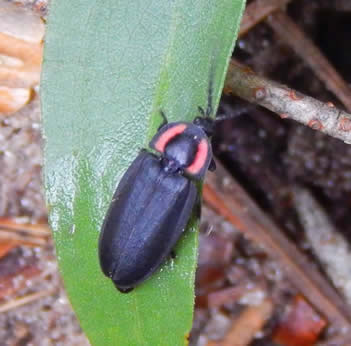 |
|
| Figure 3. a) Red-faced Warbler (© Marceline Vandewater) and | b) western firefly, or lampyrid beetle (Ellychnia sp.), a species that is not bioluminescent (© Eric Hough). |
Farther up at the trail at a wide bend in the creek we paused to watch a female Belted Kingfisher posing atop willows and alders while giving its characteristic loud, rattling calls. We then noticed several Common Nighthawks flying high up in the sky as it got later in the afternoon. As we continued to watch, we noticed more and more flocks of them across the sky until we counted upwards of 125 of them, with a handful of Violet-green Swallows mixed in. Later on as we worked our way back to the parking lot, we added a pair of Hepatic Tanagers and a Painted Redstart. Individuals of the latter species that show up above the Mogollon Rim are generally regarded as spring overshoots or post-breeding wanderers, although it is possible that some of them are locally breeding in north-flowing snowmelt drainages above the rim. Our final highlight of birding at this location came as we heard the sound of an approaching vehicle heading down the road, followed concurrently with a screeching sound that we initially mistook for squeaky wheels on the vehicle. The sound then increasingly sounded raptor-like, followed promptly by two Peregrine Falcons flying directly over us in pursuit of each other and the vehicle subsequently passing by anticlimactically.
Marceline, John, and I then headed to the campsite I had chosen off Forest Rd. 96 on spur road FR 9722U above East Clear Creek in the open ponderosa pine and Gambel oak forest to meet up with Nick and Connie Worth, who had arrived later in the afternoon. After eating dinner, the five of us went owling around forest roads of the area and were lucky enough to hear a vocal exchange at dusk between two Spotted Owls, the ‘Mexican’ subspecies (Strix occidentalis lucida) of which is federally listed as threatened under the Endangered Species Act. We initially heard an unusual higher-pitched barking than we were used to hearing from the species (Nick likened the sound to a Pomeranian dog’s barking), followed by the classic shrill, up-slurred whistle given by the female several times. It was unclear if this was an adult pair giving contact calls to locate each other at dusk or if it was juveniles calling to the mother. It should be noted that no audio playback was used to detect these owls, as doing so would be illegal due to the species’ federally-protected status. Our owling only continued a little while longer as we failed to detect any other owl or nightjar species before we headed back to camp.
Saturday, August 16, 2014
Our group awoke early the next morning to the sound of a calling Northern Pygmy-Owl, our third of that species on the expedition by that point. Since most resident forest species had bred and fledged young out of nests by this point in the season, the dawn chorus was much reduced compared to what it would have been earlier in the summer. Common species of ponderosa pine-Gambel oak forest were heard though, including Acorn Woodpecker, Plumbeous Vireo, Mountain Chickadee, Pygmy Nuthatch, Western Bluebird, Grace’s Warbler, and Hepatic Tanager. For our search of snowmelt drainages that day, we decided to split into two groups to cover the following areas:
A loop starting down Forest Roads 95 and then 139 heading down to Forest Rd. 300 on the Mogollon Rim (“The Rim Road”), continued by heading a few miles west to Forest Rd. 95 and following that up to East Clear Creek near our base camp in the afternoon. This area included Barber Lake, the Houston Brothers Trail #171, the western trailhead for Barbershop Trail #91, and Bear Canyon.
A loop starting down Forest Rds. 96 and 137 down to Forest Rd. 300 at the Mogollon Rim, continued by heading up Forest Rd. 321 back to Forest Rd. 96 near our base camp. This route included the Buck Springs Cabin area and maple groves of Forest Rd. 137.
A simple map of forest roads of this area can be found on the Coconino National Forest’s website at this link.
 |
| Figure 4. Map of AZFO expedition coverage area (© Google Earth). Overlay of Mogollon Rim Snow Melt Draws IBA (blue polygon) provided by © Arizona Audubon. Green markers denote named locations surveyed on this expedition, yellow markers denote unnamed survey points. |
Forest Roads 95 / 139 / 300:
Nick, Connie, and I departed the base camp just before 7:00am and drove slowly down Forest Rd. 96 into the Barbershop Canyon / East Clear Creek drainage system on our way towards the Forest Rd. 95 intersection. The cool, still shaded canyon was quiet at this hour of morning, but we did luck out with encountering a flock of Red Crossbills that perched in a roadside tree before flitting over to the cut bank of the road to briefly forage. At the Forest Rd. 96 / 95 intersection at the confluence of the two canyons, we briefly stopped to bird from the bridge near the parking lot. Here we detected female MacGillivray’s and Yellow Warblers sneakily foraging in the willows and alders. We continued up Forest Rd. 95 from here and periodically stopped to look and listen for birds. Through the first few stops we only managed a few of the common resident forest bird species, but then came upon more diversity once we reached the patch of trees around the mud puddle called Barber Lake. Here we found a Band-tailed Pigeon deeply cooing away, several Acorn Woodpeckers flying among their snags used to store hundreds of cached acorns, and a few Plumbeous Vireos emphatically singing away among several other expected forest species. A little ways farther south down the road we came upon a very lively mixed flock with a Cordilleran Flycatcher, one Cassin’s and several Plumbeous Vireos, several Grace’s and Yellow-rumped Warblers, and a multitude of Western Bluebirds. While species diversity was not great in this mixed flock, searching for migrants at this time of year often involves locating these mixed passerine flocks. Migrating passerines, such as vireos and warblers, often opportunistically follow along with family groups of chickadees, nuthatches, and creepers to concurrently help locate food while also increasing their survival odds by avoiding predators with “safety in numbers”.
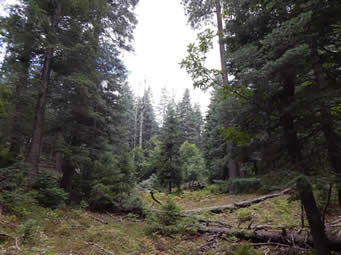 |
| Figure 5. a) Mixed-conifer habitat around a snowmelt drainage (© Eric Hough) |
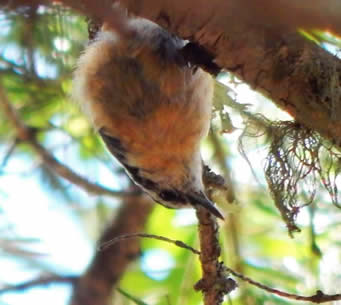 |
| and b) a Red-breasted Nuthatch (© Eric Hough). |
After several more stops with low diversity of typical forest species, we gradually began to intersect portions of snowmeltdrainages with mixed conifer habitat, dominated by Douglas-firs and white firs (Abies concolor). The vegetation in these drainages consists of more varied forest structure along with different types of food resources for birds, which often attracts migrating passerines that stopover in these higher elevation locations. Stops that we made along some of these snowmelt drainages added all three nuthatch species and a calling juvenile Northern Goshawk to our list. One drainage we wandered down into had one of our best mixed flocks of the expedition, including a Downy Woodpecker, several Mountain Chickadees, all three nuthatch species, Brown Creepers, Western Bluebirds, and Yellow-rumped Warblers, and smaller numbers of Olive, Black-throated Gray, Townsend’s, Hermit, and Red-faced Warblers. Farther up the drainage we found another Downy Woodpecker and a Williamson’s Sapsucker. At another location down the road we wandered down into a drainage and found ourselves on a segment of the Houston Brothers Trail #171, where we began to see pockets of bigtooth maples (Acer grandidentatum) appearing. As we continued down the road past the Barbershop Trailhead #91, we saw larger and denser groves of maples and occasional aspens (Populus tremuloides) mixed in with the firs, pines, and oaks. Where the road ascended onto the upper ridge of the Mogollon Rim, we began seeing the heads of some of the south-flowing canyons that drain off of the rim in addition to the upper reaches of the north-flowing ones. We encountered breeding evidence in these drainages of recently-fledged Hermit Thrushes and agitated pairs of Spotted Towhees and Dark-eyed Juncos that likely had nestlings or fledglings nearby. Migrants included a couple more Cassin’s Vireos, a Warbling Vireo, and either lingering summer resident or migrant Red-faced Warblers.
Once we reached Forest Rd. 300 along the Mogollon Rim, we stopped at a couple of overlook points to briefly scan for birds and take in the breathtaking scenery beneath the escarpment. Here we only added some Turkey Vultures, Broad-tailed Hummingbirds, a Rock Wren, and a few more Canyon Wrens to our list. As it was getting late in the afternoon and Marceline and John would be expecting us back at camp, we decided to only make a couple of stops along Forest Rd. 95 on our way back north, including a brief scan around the running stream at Bear Canyon that only yielded a few species in the afternoon doldrums.
Forest Roads 96 / 137 / 300 / 321:
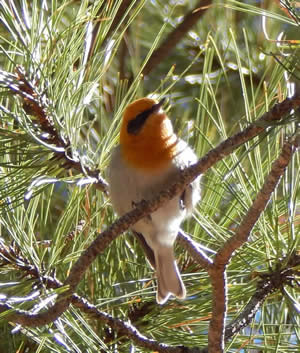 |
| Figure 6. a) Olive Warbler (© Eric Hough) |
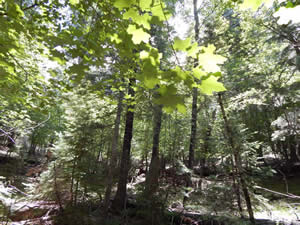 |
| and b) bigtooth maples (© Eric Hough). |
Marceline and John set out for the Buck Springs Cabin and maple grove areas off Forest Rd. 137, an area which has proven itself in the past to be a vagrant trap, such as the Black-throated Blue and Kentucky Warblers, Northern Parula, and Ovenbird that were all found around here in 2006 (fide Lauren Harter). There are also accepted records for the nearby Hospital Ridge area of an Eared Quetzal in 1992 (Rosenberg & Witzeman 1998) and a Magnolia Warbler in 2000 (Rosenberg et al. 2007). Although they did not luck out in finding any such grand vagrants, Marceline and John did encounter a Zone-tailed Hawk, an American Three-toed Woodpecker, a Williamson’s Sapsucker, a Nashville Warbler, and a few Grace’s and Hermit Warblers. When not drawn to recently-burned forests, American Three-toed Woodpeckers flake bark of dead and dying trees killed by insects, fungus, or other environmental agents in these drainages along the Mogollon Rim. Besides these uncommon woodpeckers and the mixed flocks, Marceline and John found many of the stops they made along the way to be fairly quiet overall as the other team did. While not looking at the birds, Marceline and John saw many interesting mushrooms and also detected several species of butterflies, including Orange Sulphur, Cloudless Sulphur, Dainty Sulphur, Reakirt’s Blue, Spring Azure, Gray Hairstreak, Northwestern (Atlantis) Fritillary, Variegated Fritillary, Painted Lady, Northern Crescent, Satyr Comma, and Tawny-edged Skipper.
Forest Rd. 9722U—AZFO base camp:
As Nick, Connie, and I turned onto Forest Rd. 9722U near our base camp, we happened upon Marceline and John with her vehicle parked perpendicular across the road. Puzzled, we approached and learned that they had been using the vehicle as a blind to watch a large mixed flock of birds flying to and from a puddle in the road to drink and bathe, including a first-year female Northern Parula that they had unsuccessfully been trying to photograph about five minutes before we arrived. The widely-spaced out flock of vireos, chickadees, nuthatches, bluebirds, warblers, and tanagers continued to move among the tall ponderosa pines and Gambel oaks near our camp as we searched in vain for the parula. Unfortunately, as the sky clouded up again, the birds seemed to be less interested in bathing in the road puddles. In addition to the parula, other highlights our group had were a Cordilleran Flycatcher, a Cassin’s Vireo, an Olive Warbler, a few Black-throated Gray Warblers, several Yellow-rumped and Grace’s Warblers, one Red-faced Warbler, and a few Western Tanagers, including a bright adult male feeding a begging fledgling. Later in the afternoon, a couple dozen Common Nighthawks began hunting high above the pines followed by a calling Northern Pygmy-Owl at dusk. Our owling excursion again detected the couple of Spotted Owls vocalizing to each other just after dusk, but we again did not detect any other nocturnal bird species.
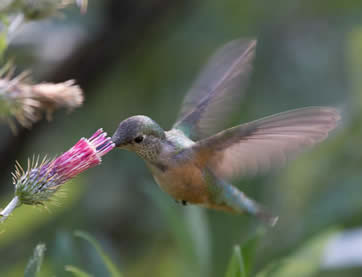 |
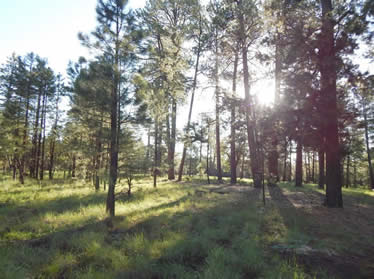 |
|
| Figure 7. a) Broad-tailed Hummingbird feeding on an Arizona thistle (© Anita Strawn de Ojeda) | b) AZFO expedition base camp along Forest Rd. 9722U (© Eric Hough). |
Sunday, August 17, 2014:
The next morning we awoke again to the whistled tooting of the Northern Pygmy-Owl just before it began getting light to the east. While we ate breakfast and packed up camp, Anita Strawn de Ojeda arrived from Holbrook to join us for surveying for birds that morning. As the sun peeked over the horizon, we began hearing the various vocalizations of a mixed flock moving about in the trees near camp. We briefly followed the flock around and found a Warbling Vireo, single Townsend’s, Hermit, and Red-faced Warblers, among several other common forest birds. Throughout the early morning we also heard the harsh, whistled, bluebird-like call of an Olive Warbler, a species with a deceptive name that recent genetic analyses have shown to be more closely related to the Old World accentors (ironically neither olive, nor a warbler).
East Clear Creek / Barbershop Creek:
Next, we headed down to the parking lot at the Forest Rds. 95 / 96 confluence, where we split into two groups to spend less than an hour searching along both East Clear Creek and its tributary, Barbershop Creek. Marceline, Nick, and Connie, headed up East Clear Creek where they found a Downy Woodpecker, a calling Northern Pygmy-Owl, and nine warbler species, including a couple each of Hermit Warblers and Painted Redstarts, and four Red-faced Warblers. However, bird activity was slow to start off due to that stretch of the canyon still being shrouded in shadow. Meanwhile, Anita, John, and I walked up Forest Rd. 96 along Barbershop Canyon, which gave us a good vantage point overlooking the canopies of trees along the creek. We heard yet another Northern Pygmy-Owl along our stretch, which given the timing and distance from where the other group heard one, possibly could have been a different individual. This area is also a good distance from where we heard the pair calling on Friday, as well as the one we heard every dawn and dusk at our base camp. Therefore, it seems probable that at least four to five Northern Pygmy-Owls were present in the East Clear Creek / Barbershop Canyon area at large (perhaps some were the dispersed offspring of a pair that bred in the area?). Other highlights for our group included a couple of Olive-sided Flycatchers and eight warbler species, including two Olive, one Black-throated Gray, and four Red-faced Warblers, and two Painted Redstarts. We also got to watch a couple of young Canyon Wrens forage around on the slabs of sandstone on the canyon walls, while adults sang nearby in the drainages.
Blue Ridge Reservoir:
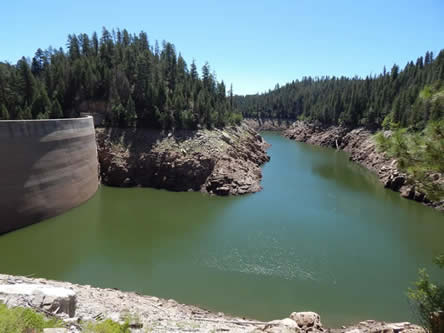 |
| Figure 8. a) Blue Ridge Reservoir (© Eric Hough) |
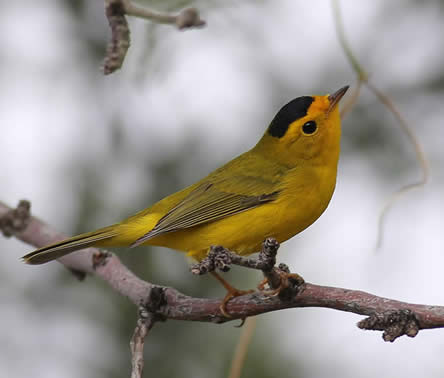 |
| and b) Wilson’s Warbler (© Marceline Vandewater). |
Our last destination of the expedition was Blue Ridge (C.C. Cragin) Reservoir, to the west of East Clear Creek, which we had to access by heading back out to State Route 87 and heading south to the signed turn for the reservoir. The water level at the reservoir was down significantly due to operations to repair the 52-year old dam. As a result, mudflats near the inflow to the reservoir seemed potentially attractive to migrating shorebirds, yet the best we could manage was a flycatching Black Phoebe. Waterfowl and waders were scarce, with fewer than a dozen Common Mergansers and Mallards, and a Great Blue Heron being the only water birds present. So, we walked the old road past the dam and birded some of the vegetation on the slopes and side drainages in hopes of picking up more migrant passerines. In a patch of boxelders and Gambel oaks we came across a couple of Virginia’s, MacGillivray’s, and Wilson’s Warblers, and a few Lazuli Buntings. Scanning with our scopes across the reservoir, we spotted an Olive-sided Flycatcher atop a snag, just minutes before we located another one atop a tree much closer to us. The blooming skyrockets (Ipomopsis aggregata) also attracted several feisty Rufous and Broad-tailed Hummingbirds fighting over nectar resources. Lastly, while walking back to our vehicles, we spotted a flyover Osprey, providing a pleasant conclusion to our expedition.
This expedition provided a snapshot of fall migration in mid-August along this portion of the Mogollon Rim and its drainages, thus giving us a glimpse of the general pattern of migration along this bioregion. While, many of the stops we made over the weekend had low diversity of resident and migrant species, the observations we did have supported the notion that migrants stopping over along the Mogollon Rim region opportunistically forage by locating moving foraging flocks of resident species to tag along with. To search for these mixed flocks it is often a matter of being in the right place at the right time. Besides regional montane breeders of the intermountain West that pass through here during migration, the Mogollon Rim is an important stopover point for species that breed in the Pacific Northwest too, such as Hermit and Townsend’s Warblers, and Rufous Hummingbirds. Overall species diversity appeared to be higher around the mixed conifer and maple patches within the snowmelt drainages of the region, suggesting the importance of these habitat types for foraging breeders and migrants alike. Along with taking into consideration the breeding residents of the region within the Mogollon Rim Snow Melt Draws IBA, land management agencies should consider the importance of these habitat types to migrating avifauna when conducting forest treatments in the region, as well. Our full species list of the expedition can be seen below in Table 1 of Appendix A. In addition, checklists for each site that we surveyed have been entered into AZFO’s eBird (ebird.org) account and shared with Arizona Audubon’s IBA eBird account.
Marceline and I would like to thank the following individuals for making the journey to participate in this expedition to explore fall migration in this under-birded, beautiful region of Arizona: John Barthelme, Nick and Connie Worth, and Anita Strawn de Ojeda.
We hope you can join us on our upcoming expeditions to investigate the diverse avifauna of our state!
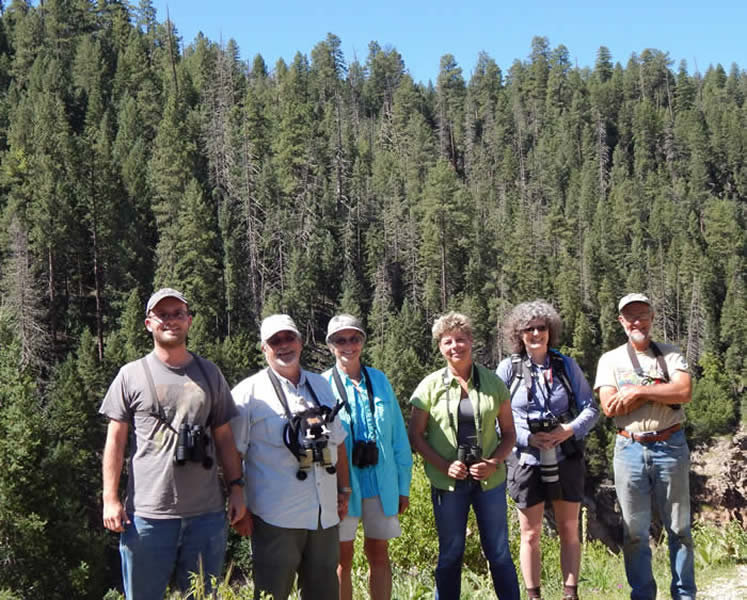 |
| Figure 9. AZFO expedition participants (from left to right): Eric Hough, Nick Worth, Connie Worth, Marceline Vandewater, Anita Strawn de Ojeda, and John Barthelme (© Eric Hough). |
Appendix A
Table 1. Total species numbers and breeding codes for the August 15-17, 2014, AZFO expedition to the Mogollon Rim / Blue Ridge Reservoir area.
| Species | Total # | *Breeding Code |
|---|---|---|
| Mallard | 1 |
|
| Common Merganser | 7 |
|
| Great Blue Heron | 1 |
|
| Turkey Vulture | 4 |
|
| Osprey | 1 |
|
| Sharp-shinned Hawk | 1 |
|
| Northern Goshawk | 1 |
FL |
| Zone-tailed Hawk | 1 |
|
| Band-tailed Pigeon | 1 |
|
| Northern Pygmy-Owl | 5 |
P |
| Spotted Owl | 4 |
P |
| Common Nighthawk | 150 |
|
| Broad-tailed Hummingbird | 26 |
|
| Rufous Hummingbird | 12 |
|
| Belted Kingfisher | 1 |
|
| Acorn Woodpecker | 20 |
|
| Williamson's Sapsucker | 2 |
|
| Downy Woodpecker | 3 |
|
| Hairy Woodpecker | 14 |
FL |
| American Three-toed Woodpecker | 1 |
|
| Northern Flicker | 31 |
|
| Peregrine Falcon | 2 |
|
| Olive-sided Flycatcher | 3 |
|
| Western Wood-Pewee | 3 |
|
| Cordilleran Flycatcher | 5 |
|
| Black Phoebe | 1 |
|
| Plumbeous Vireo | 31 |
|
| Cassin's Vireo | 4 |
|
| Warbling Vireo | 4 |
|
| Steller's Jay | 36 |
|
| Common Raven | 9 |
|
| Violet-green Swallow | 21 |
|
| Mountain Chickadee | 87 |
|
| Red-breasted Nuthatch | 12 |
|
| White-breasted Nuthatch | 46 |
|
| Pygmy Nuthatch | 129 |
|
| Brown Creeper | 29 |
|
| Rock Wren | 1 |
|
| Canyon Wren | 17 |
FY |
| House Wren | 36 |
|
| Ruby-crowned Kinglet | 6 |
|
| Western Bluebird | 113 |
FY |
| Hermit Thrush | 10 |
FL |
| American Robin | 3 |
|
| Olive Warbler | 5 |
|
| Orange-crowned Warbler | 2 |
|
| Nashville Warbler | 1 |
|
| Virginia's Warbler | 15 |
|
| MacGillivray's Warbler | 8 |
|
| Northern Parula | 1 |
|
| Yellow Warbler | 4 |
|
| Yellow-rumped Warbler | 74 |
|
| Grace's Warbler | 23 |
|
| Black-throated Gray Warbler | 6 |
|
| Townsend's Warbler | 2 |
|
| Hermit Warbler | 7 |
|
| Wilson's Warbler | 6 |
|
| Red-faced Warbler | 17 |
|
| Painted Redstart | 5 |
|
| Spotted Towhee | 8 |
FY, PN |
| Chipping Sparrow | 6 |
FL |
| Dark-eyed Junco | 67 |
FY, A |
| Hepatic Tanager | 5 |
|
| Western Tanager | 5 |
|
| Black-headed Grosbeak | 2 |
|
| Lazuli Bunting | 4 |
|
| Bullock's Oriole | 1 |
|
| Red Crossbill | 15 |
|
| Lesser Goldfinch | 4 |
*Breeding Codes: Pair (P), Agitated behavior (A), Probable Nest (PN), Feeding dependent fledged young (FY), recent fledglings/juveniles (FL).
|
©2010 |
HOME | | | REPORT SIGHTINGS | | | PHOTOS | | | BIRDING | | | JOURNAL | | | ABOUT US | | | CHECKLISTS | | | AZ BIRD COMMITTEE | | | EVENTS | | | LINKS |